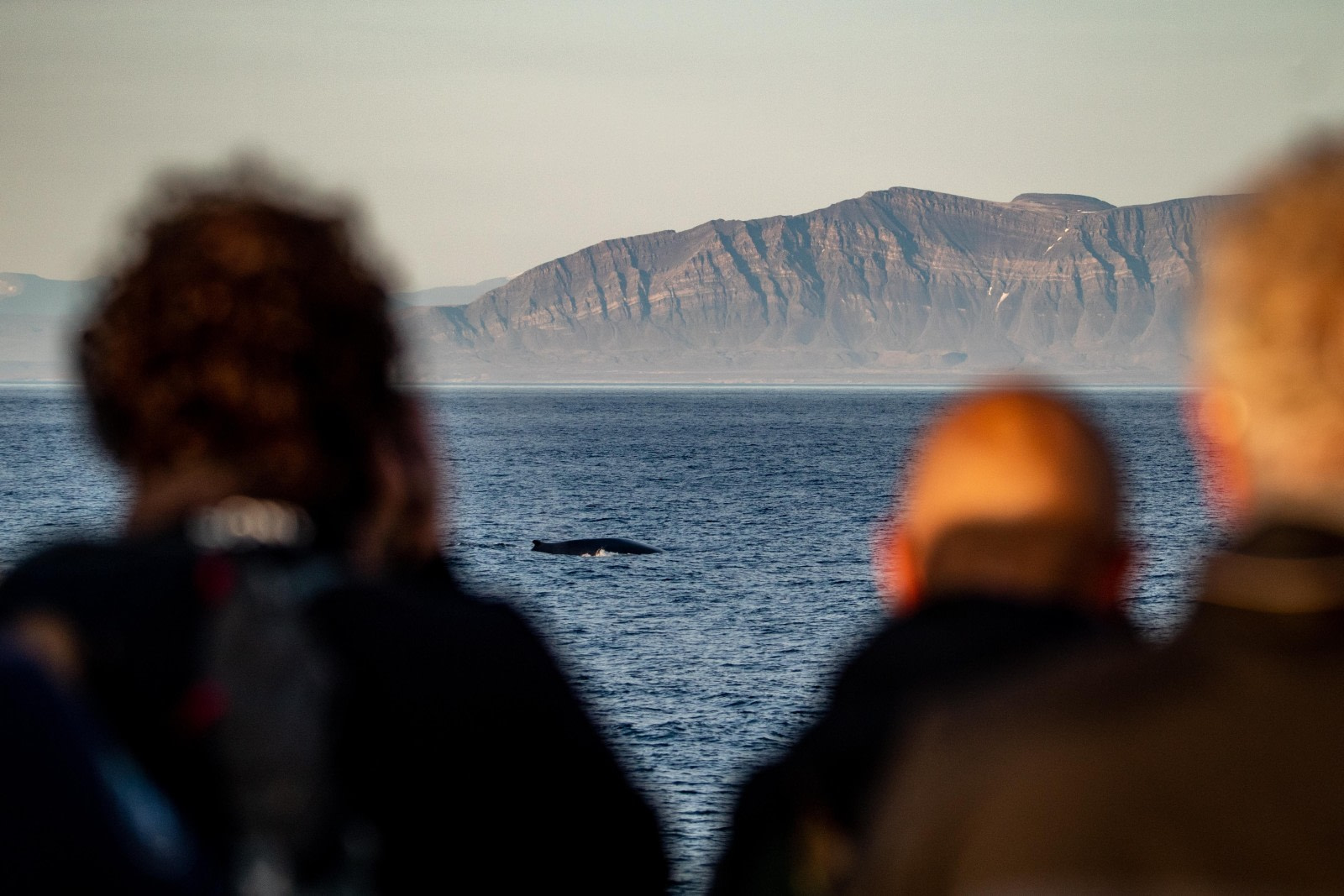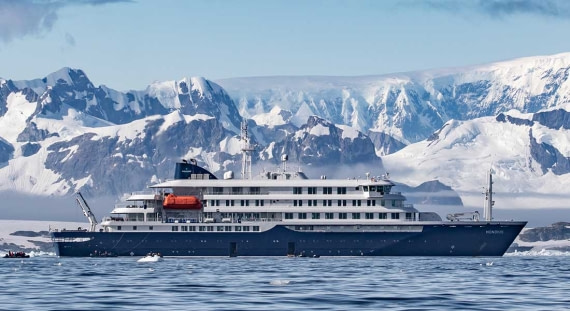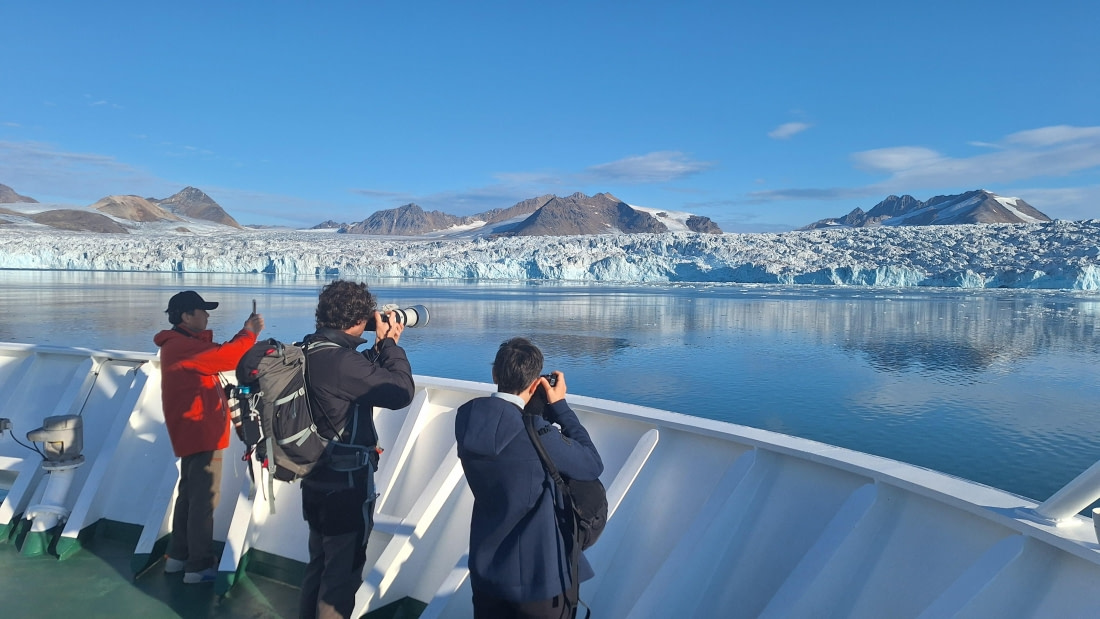| Datum: |
12.08.2024 |
| Position: |
80°06.2'N, 031°22.6'E |
| Wind: |
SSE 6 |
| Wetter: |
Teilweise bewölkt |
| Lufttemperatur: |
+4 |
Heute sind wir auf Kvitøya angekommen. Eine der abgelegensten Gegenden von Svalbard und ein Gebiet, das für schlechtes Wetter berüchtigt ist. Wenn es keinen Wind gibt, kann es Nebel geben. Und wenn es keinen Nebel oder Wind gibt, dann kann es großen Wellengang geben. Und selbst wenn das Wetter perfekt ist, kann es sein, dass Bären an Land sind und uns daran hindern, anzulanden. Alles in allem ein großartiger Ort, um ein Abenteuer zu erleben ;).
Wir kamen früh an und das Expeditionsteam begann mit der Planung des Vormittags unter Berücksichtigung der Bedingungen und natürlich mussten sie die Küstengebiete nach Eisbären absuchen. Und Bären wurden gefunden, also keine Anlandung an diesem Morgen, aber eine aufregende Zodiacfahrt erwartete uns. Es gab ziemlich viel Wind und Wellengang, so dass das Einsteigen in die Zodiacs an der Muscheltür nicht einfach war, aber wir haben es alle perfekt geschafft. Zeit, ein paar Bären und andere Tiere zu sehen.
Alle Zodiacs machten sich auf den Weg zu dem schlafenden Bären, dem wir den Namen Bär Nr. 1. Als wir uns der Küste näherten, entdeckten wir Walrosse, so dass wir unsere Fahrt verlangsamten, denn Walrosse können sehr angriffslustig sein und später an diesem Morgen erlebte einer der Guides, was dann passieren kann, als sein Boot durchbohrt wurde.
Unser erster Bär war ziemlich nah am Ufer und schlief mit dem Gesicht zu uns in einer Locke. Er schlief fest und bewegte sich nicht viel. Normalerweise würden wir warten, bis der Bär sich bewegt, aber heute zogen wir weiter, da wir Informationen hatten, dass es entlang der Küste noch mehr Bären gibt. Als wir der Küste folgten, sahen wir viele Walrosse im Wasser, und einige hielten sich auf einer kleinen Insel auf. Wir hatten auch einen großartigen Blick auf die Gletscherkappe, die auf der Spitze von Kvitøya liegt. An der Spitze ist sie mehr als 400 Meter hoch.
Auf dem Weg zu weiteren Bären weiter unten an der Küste entdeckten wir noch einen weiteren, den wir Bär Nr. nannten. 2. Auch dieser schlief, aber nicht so tief, und er hob ein paar Mal den Kopf, bevor er sich wieder hinlegte. Die Sichtungen wurden immer besser! Bei diesem Bären folgten wir einer Schlangenformation von Zodiacs vor dem Bären, um sicherzustellen, dass jeder eine gute Sicht hatte, ohne ihn zu stören. Manchmal fragen wir uns, was diese Bären denken müssen, wenn sie uns sehen.
Wir setzten unsere Route entlang der Küste fort und kamen an einer großen Gruppe von Walrossen vorbei, die sich auf einer kleinen Insel ausruhten. Sie waren etwas erschrocken über unsere Anwesenheit, so dass wir Abstand halten mussten, um sie nicht zu erschrecken. Dann fanden wir zu unserer Überraschung 3 weitere schlafende Bären um die Ecke, direkt hinter dem Sandstrand. Es waren die Bären Nr. 3, 4 und 5. 5 Bären an einem Morgen ist außergewöhnlich! Von einem Forschungsschiff in der Nähe erhielten wir die Information, dass sich ein Walkadaver am Strand befand, was unser Glück an diesem Morgen erklärte. Ein Walkadaver ist der Jackpot für Eisbären, denn der Kadaver enthält eine Menge Blubber, und darauf sind die Bären scharf. Sie brauchen Kalorien, und deshalb ist Walblubber die perfekte Nahrung für sie.
Diese Bären waren fast alle ganz nah an der Küste, und einer saß wie eine arktische Sphinx da und beobachtete uns. Der Vormittag verging wie im Fluge, da wir so viele und so unterschiedliche Tierarten entdeckten. Auf dem Rückweg haben wir dann selbst den Jackpot geknackt. Einer der Bären war aufgestanden und direkt an den Strand gelaufen. Zuerst dachten wir, es sei ein Eisbär, den wir zuvor gesehen hatten, aber dann stellten wir fest, dass alle anderen Bären immer noch an denselben Stellen schliefen, an denen wir sie zuerst gefunden hatten. Dies war also unser 6. Bär an diesem Morgen. Er war sehr nah an den Booten, und wir hatten einen tollen Blick auf den Bären, der sich uns gegenüber sehr neugierig zeigte. Bis er sich umdrehte, ein paar Kothäufchen fallen ließ und davonlief. Ein sehr lustiger Moment zum Abschluss einer unglaublichen und unglaublichen Begegnung. Unglaublich war auch, wie schnell der Bär aus unserem Blickfeld verschwand, als er sich direkt hinter dem Strand in tieferes Gelände begab. Das ist der Grund, warum unser Expeditionsteam unsere Landeplätze vor jeder Aktivität auskundschaftet.
Auf dem Rückweg lächelten wir alle vor Glück und Aufregung über eine so nahe Begegnung. Wir schauten nach, ob einer der anderen schlafenden Bären mehr Aktivität zeigte, aber sie waren alle im Traumland und uns war inzwischen ziemlich kalt geworden. Es wurde Zeit, zurück zum Schiff zu gehen, um eine heiße Schokolade zu trinken und eine warme Dusche zu nehmen. Was für ein spektakulärer Morgen!
Nach dem Mittagessen wurden wir zu einem Vortrag von Marcel eingeladen. Er erklärte uns alles, was es über den Eisbären zu wissen gibt. Auf diese Weise konnten wir viel besser verstehen, wie unglaublich diese Tiere sind und welche Strapazen sie in ihrem Leben ertragen müssen.
Wir bekamen auch einen Vortrag von Misha über den Vogelzug. Er zeigte uns mit bewegten Karten, wie die Vögel dieses Planeten im Laufe der Jahreszeiten wandern und wie sie ständig durch die Aktivitäten von Menschen und menschlichen Haustieren bedroht sind.
Draußen konnten wir die ganze Zeit auf unserer Backbordseite die Kvitoya sehen. Die Sonne kam ziemlich oft heraus, was für schöne Aussichten sorgte.
Während der Rekapitulation wurden wir mit weiteren interessanten Geschichten des Expeditionsteams verwöhnt. Hana erzählte uns aus persönlicher Erfahrung über das Leben auf einem Forschungsschiff. Eine einwöchige Reise, die sie im Hornsund-Fjordsystem mit koordiniert hatte. KJ erzählte uns mehr über die Ortungsgeräte, mit denen die Wissenschaftler die Eisbären aufspüren. Bei der neuen Technologie hat sich einiges geändert, um das Leben der Bären weniger zu beeinträchtigen. Schließlich erzählte uns Chloe von einem der kleinsten Tiere der Welt, dem Wasserbären. Ein unglaubliches Tier, das in allen Umgebungen überleben kann, in denen es von Wissenschaftlern getestet wurde.
Genießen Sie Ihr Abendessen und gute Nacht!
































